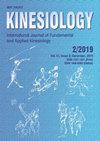Sex and standard levels differences in anthropometric and physical fitness characteristics in youth handball players
IF 0.9
4区 医学
Q4 REHABILITATION
引用次数: 1
Abstract
This study analyzed the relationships between throwing velocity and anthropometric and fitness parameters in young female and male handball players of different ages. A total of 159 players participated: females under-16 (FU16, n=44) and under-14 (FU14, n=21); males under-16 (MU16, n=54) and under-14 (MU14, n=40). The following was measured: body height, arm span, body mass, total finger span, hand length, maximal isometric handgrip force, handball throwing velocity, 20-m sprints, countermovement jump, and change of direction. Group MU16 showed significantly (p<.05) greater values of anthropometric characteristics than groups FU16 and MU14. No significant differences were observed between FU14 and MU14 in any of the anthropometric variables analyzed, or between the two female groups (FU16 vs. FU14). MU16 showed significantly (p<.05) better performance in all fitness parameters than FU16 and MU14. No significant differences were observed between FU14 and MU14 or between FU16 and FU14. Throwing performance correlated (p<.05) with almost all the anthropometric and fitness parameters evaluated within each group. Taken together, male handball players showed greater anthropometric and fitness characteristics in the U16 compared to the U14, whereas no substantial differences were observed in female handball players between the two groups. Handball throwing velocity is associated with body and hand dimensions and other physical performance parameters.青少年手球运动员人体测量和体质特征的性别和标准水平差异
本研究分析了不同年龄的青年男女手球运动员投掷速度与人体测量学和体能参数的关系。共有159名球员参加:16岁以下的女性(FU16, n=44)和14岁以下的女性(FU14, n=21);男性16岁以下(MU16, n=54)和14岁以下(MU14, n=40)。测量身高、臂展、体重、总指展、手长、最大等距握力、手球投掷速度、20米冲刺、反动作跳跃、方向变化。MU16组的人体测量特征值显著高于FU16和MU14组(p< 0.05)。在分析的任何人体测量变量中,FU14和MU14之间或两组女性之间(FU16 vs. FU14)均未观察到显著差异。MU16在各适应度指标上均显著优于FU16和MU14 (p< 0.05)。FU14和MU14之间、FU16和FU14之间无显著差异。投掷成绩与各组中几乎所有的人体测量和体能参数相关(p< 0.05)。综上所述,与U14相比,U16的男性手球运动员表现出更大的人体测量学和健康特征,而两组之间的女性手球运动员没有明显差异。手球投掷速度与身体和手的尺寸以及其他物理性能参数有关。
本文章由计算机程序翻译,如有差异,请以英文原文为准。
求助全文
约1分钟内获得全文
求助全文
来源期刊

Kinesiology
REHABILITATION-SPORT SCIENCES
CiteScore
1.90
自引率
8.30%
发文量
16
审稿时长
>12 weeks
期刊介绍:
Kinesiology – International Journal of Fundamental and Applied Kinesiology (print ISSN 1331- 1441, online ISSN 1848-638X) publishes twice a year scientific papers and other written material from kinesiology (a scientific discipline which investigates art and science of human movement; in the meaning and scope close to the idiom “sport sciences”) and other adjacent human sciences focused on sport and exercise, primarily from anthropology (biological and cultural alike), medicine, sociology, psychology, natural sciences and mathematics applied to sport in its broadest sense, history, and others. Contributions of high scientific interest, including also results of theoretical analyses and their practical application in physical education, sport, physical recreation and kinesitherapy, are accepted for publication. The following sections define the scope of the journal: Sport and sports activities, Physical education, Recreation/leisure, Kinesiological anthropology, Training methods, Biology of sport and exercise, Sports medicine and physiology of sport, Biomechanics, History of sport and Book reviews with news.
 求助内容:
求助内容: 应助结果提醒方式:
应助结果提醒方式:


